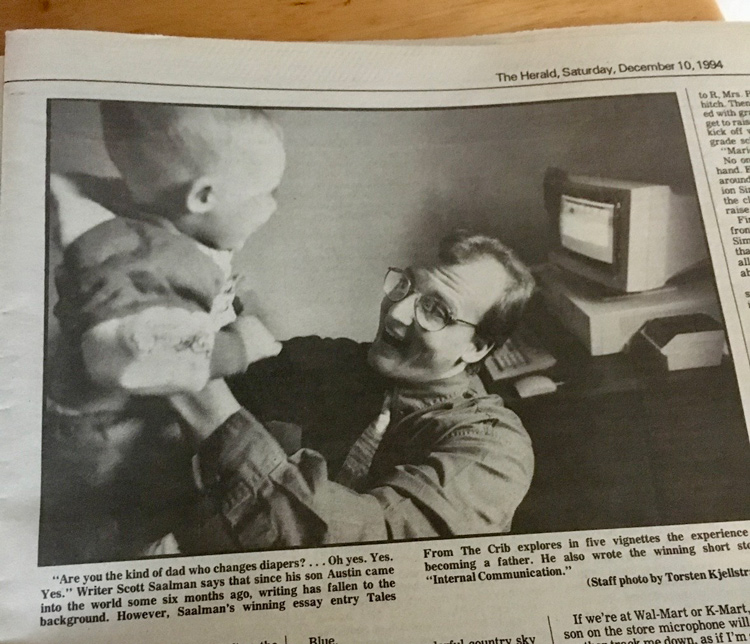Lately, I have been nostalgic for babies, thanks to my son, Austin, turning 30 last week. Thirty isn’t old (try telling that to my son) – but him turning 30 does make me old (if you must ask . . . add 30 more years to the equation). Yes, our kids age us.
When I was only a few months from turning 30, back in 1994, I was anticipating first-time fatherhood, doing all those things first-time parents do.
Here are details about one of those things.
1994.
The baby isn’t born yet, but there are things that must be done beforehand to turn young men into fathers.
There is courage to be mustered, and time must be set aside to contemplate the perseverance of the human spirit, but above all, young men must condition themselves to maintain a constant state of both physical and mental grace under fire.
I tell you this because, if you haven’t guessed, I had to assemble a single drop rocker hardware crib.
Pressure mounted even before step one: WARNING: FAILURE TO FOLLOW THESE WARNINGS AND ASSEMBLY INSTRUCTIONS COULD RESULT IN SERIOUS INJURY OR DEATH.
I shuddered. It all seemed so … well … responsible. A life could be at risk based on something I do of a mechanical nature. I am the self-appointed poster child for the assembly-impaired. I hyperventilate at the simplest threats of home improvement. For me, even refilling the ice tray becomes a trial of life.
STEP ONE: Tool requirements: Phillips screwdriver and hammer.
I couldn’t believe the instructions were so technical right off the bat. They couldn’t just say screwdriver; they had to use that Phillips word. I wish I had taken shop class where, perhaps, the Phillips thing had been defined. Plus, I’ve never had good experiences with hammers. The thought of using a hammer haunted me through the whole crib construction process. (Why don’t hammers come with instructions?)
STEP TWO: Attach stationary side. What followed was a hellish configuration of connecting nuts, hangar bolts and a lot of wretched little parenthetic secondary instructions that looked something like this:
(See (Figure A) Figure (Figure D) B)
Or
(G) (O) (O) (D) (L) (U) (C) (K) (S) (U) (C) (K) (E) (R)
Step three consisted of an array of rocker locks, tapping screws, bolts, teething rails and drop side rails. I stared at these parts in disbelief. My God, I thought, UPS obviously got our order mixed up with something from Cape Canaveral. I envisioned a NASA engineer at that very moment wondering how to fit a solid rocket booster onto our wayward baby crib.
At that point, I pondered merely putting a pillow in the crib’s cardboard box so that could be the crib.
The only consolation about step three: it didn’t require a hammer.
STEP FOUR: Attach side rail to crib.
(See Figure D). Holding side rail with teething rail up, insert drop side rod thru hole in the drop side rail; then thru hole in spring rest bracket; then place bumper spring (B) on rod before inserting rod thru bottom of hole side rail … left foot red … right foot green.
I twisted and cursed and frantically battled the maple Bassett beast until the shape of an actual baby crib miraculously began to form. Through it all, I worried about all those terrible sounding hex head machine screw things (see Figure G) – it sounded like something from the mad mind of Stephen King. What puzzled me even more was the crib was almost built, but nowhere had I been instructed to use the dreaded hammer.
By the end of step four – still no mention of the hammer – the crib’s four walls were attached, and it was basically completed. All that was left was the final step of installing the bed springs and mattress.

A 30-year-younger Scott Saalman with his now 30-year-old son Austin. This photo appeared in The Dubois County Hearld on Saturday, Dec. 10, 1994. (Photo provided)
I must admit I was really feeling good about my crib-building experience. I shook the crib to test its sturdiness – the whole contraption held – and was actually feeling fatherly for the first time, truly believing that Baby X would be safe in something I constructed.
But the triumphant feeling didn’t last long when I started to reach over for the spring and mattress. I realized then that I had built myself within the crib. A trap maker caught in his own trap, so to speak.
I shook the bars and spindles, hoping to find a simple way out of the crib without undoing everything I had done. The sides were too high to step over and too low to slip under.
It dawned on me then: now I know what the hammer is for.
Contact: scottsaalman@gmail.com

